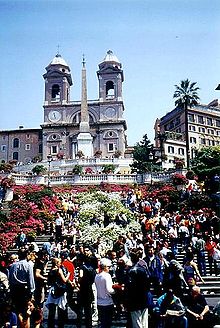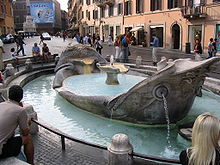Spanish stairs
The Spanish Steps ( Italian Scalinata di Trinità dei Monti , the German name is derived from the Piazza di Spagna below ) in Rome is one of the most famous open staircases in the world.
History of origin
The Spanish Steps were built from 1723. It goes back to the urban planning ambitions of Pope Innocent XIII. Before the stairs were built, the wildly overgrown slope that led down from the church of Santa Trinità dei Monti to Piazza di Spagna was perceived as an unsuitable end to the urban area that was now built up. The Piazza di Spagna got its meaning mainly from the Spanish embassy to the Holy See , which has its seat here. The square in front of the Spanish embassy was on Spanish territory and any foreigner who stayed there without a permit could be enlisted in the Spanish army. A right of asylum vis-à-vis the Vatican could also be granted here.
Contrast of interests between France and the Pope
In addition to the interests of the Pope, those of the French king appeared very early on . With a staircase a solemn ascent to that of King Ludwig XII. Trinità dei Monti church financed by France . As can be read on an inscription on the lower landing of the stairs, the French ambassador Etienne Gueffier left a considerable sum of money for the construction of a staircase on his death in 1661. However, it should take until 1725 for the stairs to be completed. In the inscription, OPUS AUTEM VARIO RERUM INTERVENTU is enunciated in terms of 'the intervening of different things' . Behind this is a conflict of interest between the French king and the Pope. The staircase was supposed to be a French monument, which could not be linked to the Pope's claim to power. The competition between king and pope can still be seen today in the lilies of the Bourbons on the outer lateral pillars and the eagles as the coat of arms of Pope Innocent XIII. read on the inner pillars. Lilies and eagles are also repeated on the four balls at the beginning of the stairs.
The Sun King Louis XIV originally wanted to close the stairs with an equestrian statue that glorified him . However, this show of force by the French protecting power was unacceptable to the popes. The conflict between king and pope initially meant that nothing happened. Benedict XIII. then enforced in 1721 that the staircase was built in the Roman style. Louis XV had to be satisfied with a plaque. Pope Clement XII. then wanted to close the stairs with an obelisk in 1733 , which should finally demonstrate the power of the popes also against France. However, due to French protests, such plans were rejected for the time being. On February 13, 1787, Goethe saw the excavation work for the foundation of the obelisk begin. It was not until 1789, when the French Revolution overthrew the royal family there, that the obelisk could be erected.
The construction of the stairs
The design for the Spanish Steps comes from Francesco De Sanctis , who wrote about Pope Clement XI. , the predecessor Innocent XIII, prevailed against Alessandro Specchi . The latter had already successfully carried out a similar contract with the Ripetta harbor, which was later demolished . De Sanctis' problems were considerable: at the beginning of the staircase, which was built from 1723 to 1725, two lines of sight meet: on the one hand, the view to the north to Via del Babuino , and on the other hand, to the west to Via Condotti . The staircase begins with a central staircase and two parallel side runs. After a third of the incline, all three meet on a first terrace, only to separate again and to flow around the second terrace wall. This is followed by a narrowing central staircase, which divides again in front of the last terrace wall and finally leads to the Trinità dei Monti church. By dividing the staircase into three parts, De Sanctis also referred to the church on the hill, dedicated to the Holy Trinity . The effect of the stairs is enhanced by the fact that some stairs are convex , while others are concave . The structure overcomes a height difference of 23 meters, is 68 meters long, measures 40 meters wide in the middle terrace and spans 52 meters with the upper two-part staircase.
Fontana della Barcaccia
On the Piazza di Spagna in front of the stairs is the older Fontana della Barcaccia , built by Pietro Bernini , Giovanni Lorenzo Bernini's father , in 1628 and 1629 . Allegedly, a boat was carried here during a flood of the Tiber on Christmas days in 1598 and was left lying there when the tide receded. This inspired Bernini to create the fountain in the shape of a boat.
The Spanish Steps today
The Spanish Steps are one of the most famous landmarks in Rome. It is a popular meeting place for tourists. The stairs have a total of 136 steps.
The area around Via Condotti at the foot of the stairs has become a luxury shopping district with shops such as Bulgari , Gucci and Prada . Right next to the Spanish Steps is the Keats Shelley Museum on the right and Babington's Tea Rooms on the left . Both the former apartment of the English writer Percy Bysshe Shelley , in which John Keats also lived and died, as well as the old English tea room, are witnesses of the international artistic community that lived around the Piazza di Spagna in the 18th and 19th centuries. Right at the beginning of Via Condotti is also the Caffè Greco , which was a popular meeting place for the German Romans and Nazarenes in the 19th century and which still reminds of these times with various exhibits.
Sitting on the stairs has been prohibited since 2019.
literature
- Reinhard Raffalt : Concerto Romano . 14th edition. Prestel, Munich 1999, ISBN 3-7913-2236-2 (first edition: 1955).
- Wolfgang Lotz : The Spanish Steps. Architecture as a means of diplomacy . In: Bibliotheca Hertziana (ed.): Roman yearbook for art history . tape 12 . Wasmuth, 1969, ISSN 0258-557X , p. 39-94 .
- Roland Günter : Rome, Spanish Steps: Architecture, experiences, ways of life . VSA, Hamburg 1978, ISBN 3-87975-155-2 .
- Anton Henze: Art Guide Rome. Reclam, Stuttgart 1994, ISBN 3-15-010402-5 , pp. 304-305.
- Eckart Peterich: Rome. 2nd edition, Prestel, Munich 1998, ISBN 3-7913-2043-2 .
- Marco Bussagli (Ed.): Rome - Art & Architecture . Könemann, Cologne 1999, ISBN 3-8290-2258-1 .
- Klaus Bartels : Rome's speaking stones. 2nd edition, Zabern, Mainz 2001, ISBN 3-8053-2690-4 .
- Heinz-Joachim Fischer : Rome. Two and a half millennia of history, art and culture of the Eternal City. DuMont, Cologne 2001, ISBN 3-7701-5607-2 , pp. 214-217.
Web links
- The Spanish Steps in Rome
- Spanish Steps : Panorama Shot (English)
- www.piazzadispagna.it (English / Italian)
Individual evidence
- ↑ In the Italian trip he noted: "The foundation for the new obelisk is being dug on Trinita di Monte, (...)" Later, in the section The Roman Carnival , he reports how the design of the monument in 1788 was mocked in the masking because of the base was felt to be disproportionately high: “We remember a single suggestive mask. An obelisk was to be erected in front of the Trinità del monte church. The audience was not very satisfied with it, partly because the space is tight, partly because a very high pedestal had to be built under the small obelisk in order to raise it to a certain height. One of them therefore took the opportunity to wear a large white pedestal as a cap, on which a very small reddish obelisk was attached. (...) “- Johann Wolfgang Goethe: Italian journey . Edited by Andreas Beyer and Norbert Miller. In: Karl Richter u. a. (Ed.): All works according to the epoch of his work. Munich edition . tape 15 . Carl Hanser Verlag, Munich / Vienna 1992, p. 201 and 584-585 . - Johann Wolfgang Goethe: Italian journey . Special edition according to Volume 11 of the Hamburg edition. Ed .: Herbert von Eine. 6th edition of the special edition. Verlag C. H. Beck, Munich 1998, p. 168 and 494-495 .
- ↑ Stefan Wagner: The eternal steps. In: focus.de. July 31, 2000, accessed October 2, 2019 .
- ↑ A. Maschewski: Berlin now also has the Spanish Steps. In: morgenpost.de. September 30, 2005, accessed October 2, 2019 .
- ↑ Rome's police force tourists off the Spanish Steps. In: welt.de. August 7, 2019, accessed October 2, 2019 .
Coordinates: 41 ° 54 ′ 22 " N , 12 ° 28 ′ 58" E






